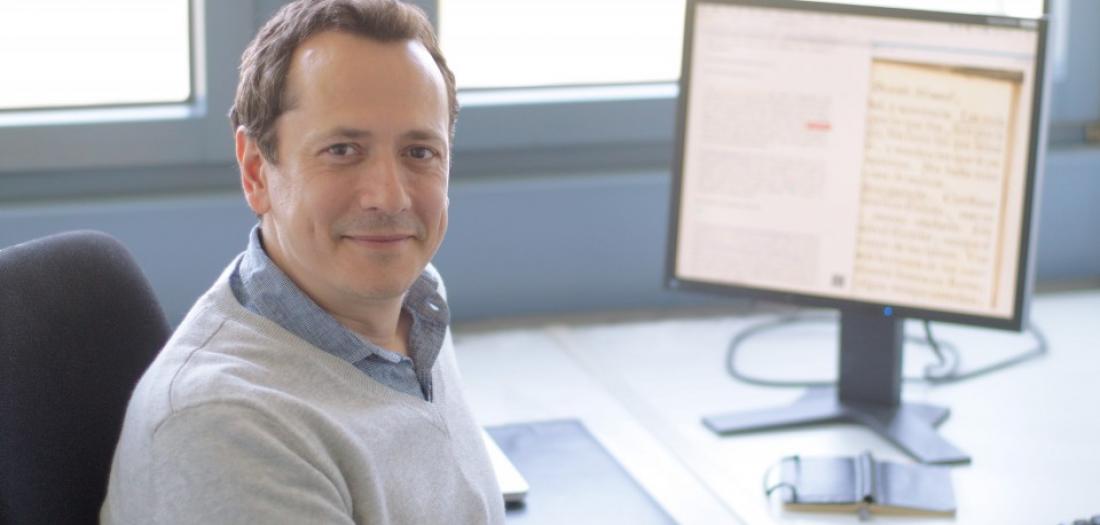Edition of the marginal notes
José L. Losada Palenzuela on his digitization project on Arthur Schopenhauer's marginalia
06.05.2016 | General, Academic exchange

Dr. José Luis Losada Palenzuela
Arthur Schopenhauer (1788-1860) is well known as a philosopher. What is less well known, however, is that he was also a translator. For example, he translated the moral treatise Oráculo manual y arte de prudencia by the Spanish Baroque writer Baltasar Gracián (1601-1658) into German. Thanks to Schopenhauer's translation, Gracián's work became known again in Germany, and so it is not surprising that many even think that Schopenhauer himself was the author of the text.
Dr. José L. Losada Palenzuela, who has been a guest at the Trier Center for Digital Humanities (TCDH) since March, did his doctorate on Schopenhauer's translation of hand oracles and the art of sophistication. The Spanish edition that the philosopher used for his translation is now in the Frankfurt University Library, peppered with his markings and notes. Losada would now like to convert these marginalia into a digital edition.
He has found the right environment for this one-man project here at TCDH. As part of a three-month DAAD scholarship, he would like to benefit from the know-how of the competence center, especially in the field of standardized labeling of texts with XML-TEI.
Schopenhauer himself, who cultivated a philosophical pessimism, would not have been at all happy about this project, Losada suspects with a wink, "That is nonsense, he would say." He would like to make a research contribution with the digital edition, and in fact a freely accessible indexing of Schopenhauer's marginalia could be an enrichment - not only for literary studies, but also for the history of philosophy and people. According to Losada, they not only document the translation process, but also provide information about the world of thought and biography of the philosopher Schopenhauer.
Why did Schopenhauer take on this work by Gracián? "He was of the opinion that every person, regardless of their status, can become 'smarter' through the book," says Losada, "but at that time the term 'cleverness' was understood to mean more practical knowledge." The collection of 300 aphorisms , that is, wisdom of life, has not lost any of its topicality to this day: “The manual is still a bestseller in the USA. It is sold, for example, as a guide for entrepreneurs. "
Schopenhauer did not set himself an easy task with the translation. "Translating the terminology of philosophy is very complicated," says Losada, "for example, the well-known terms such as 'understanding' and 'reason', which were first distinguished precisely by Kant, cannot simply be translated into another language, there they have a philosophical connotation. " In his translation, Schopenhauer therefore had to take genuine content into account. “You can see that from the fact that Schopenhauer, for example, translated the term 'cultura' from Gracián's work with the word 'education'. Schopenhauer himself, however, hardly used the term 'education' in his main work. “But in some places he also interpreted terms against the background of his own worldview and incorporated them into his translation.
In order to uncover such structures, Losada typologizes in his Edition Marginalia according to the external form by distinguishing between vertical markings (single or multiple), changes, footnotes and underlining. In the second step, Losada differentiates the marginal notes according to their content. Here he wants to show in which areas Schopenhauer, for example, went through a process of knowledge, agreed to the annotated content or confronted it, even identified with it, or which passages reappear as quotations later in the main work of the philosopher. "E.g. Schopenhauer only underlined proverbs. That shows how important these were to him, ”states Losada.
In the future, users of the online edition could have a user interface on which appropriate interpretations and references can be displayed by mouseover over the marginalia. At the TCDH, Losada now has the opportunity to promote this project beyond his teaching activities in Poland. This is the perfect place, says Losada. "After all, this is a digital edition and I was already familiar with the center primarily because of its great projects in this area. I used the Goethe dictionary, for example, for my dissertation." Losada says that he was a bit unsettled at first because the TCDH actually implements much larger projects. He is all the more pleased that he has the opportunity to present his work here, bring it up for discussion and get helpful feedback. “The colleagues here know their way around very well and are not afraid to express constructive criticism. This exchange is very fruitful. "

